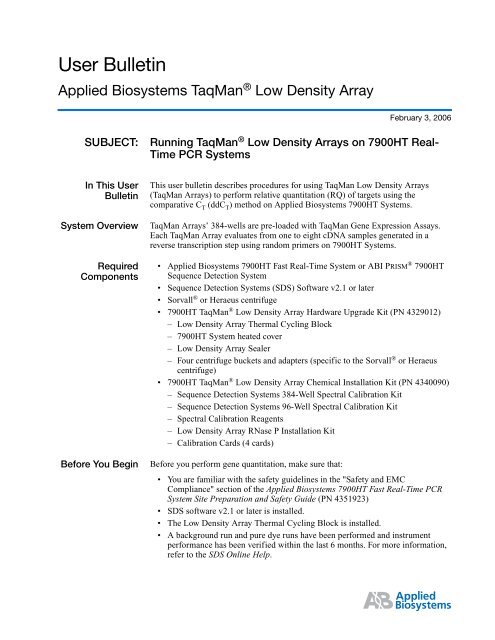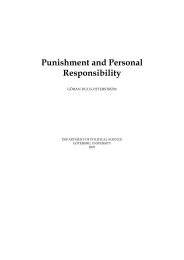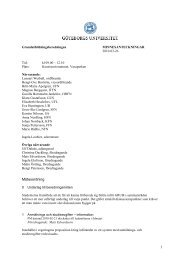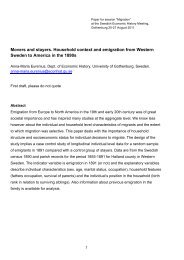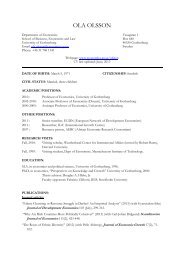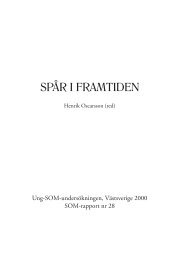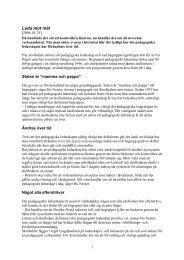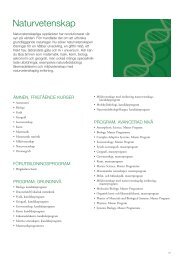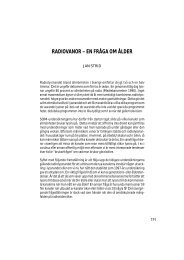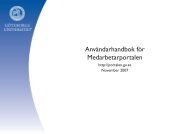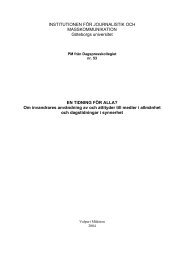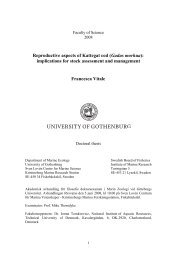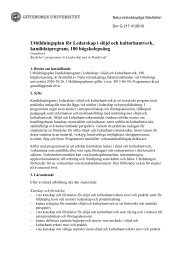You also want an ePaper? Increase the reach of your titles
YUMPU automatically turns print PDFs into web optimized ePapers that Google loves.
User Bulletin<br />
Applied Biosystems TaqMan ® Low Density Array<br />
February 3, 2006<br />
SUBJECT:<br />
Running TaqMan ® Low Density Arrays on 7900HT Real-<br />
Time PCR Systems<br />
In This User<br />
Bulletin<br />
System Overview<br />
Required<br />
Components<br />
Before You Begin<br />
This <strong>user</strong> <strong>bulletin</strong> describes procedures for using TaqMan Low Density Arrays<br />
(TaqMan Arrays) to perform relative quantitation (RQ) of targets using the<br />
comparative C T (ddC T ) method on Applied Biosystems 7900HT Systems.<br />
TaqMan Arrays’ 384-wells are pre-loaded with TaqMan Gene Expression Assays.<br />
Each TaqMan Array evaluates from one to eight cDNA samples generated in a<br />
reverse transcription step using random primers on 7900HT Systems.<br />
• Applied Biosystems 7900HT Fast Real-Time System or <strong>ABI</strong> PRISM ® 7900HT<br />
Sequence Detection System<br />
• Sequence Detection Systems (SDS) Software v2.1 or later<br />
• Sorvall ® or Heraeus centrifuge<br />
• 7900HT TaqMan ® Low Density Array Hardware Upgrade Kit (PN 4329012)<br />
– Low Density Array Thermal Cycling Block<br />
– 7900HT System heated cover<br />
– Low Density Array Sealer<br />
– Four centrifuge buckets and adapters (specific to the Sorvall ® or Heraeus<br />
centrifuge)<br />
• 7900HT TaqMan ® Low Density Array Chemical Installation Kit (PN 4340090)<br />
– Sequence Detection Systems 384-Well Spectral Calibration Kit<br />
– Sequence Detection Systems 96-Well Spectral Calibration Kit<br />
– Spectral Calibration Reagents<br />
– Low Density Array RNase P Installation Kit<br />
– Calibration Cards (4 cards)<br />
Before you perform gene quantitation, make sure that:<br />
• You are familiar with the safety guidelines in the "Safety and EMC<br />
Compliance" section of the Applied Biosystems 7900HT Fast Real-Time PCR<br />
System Site Preparation and Safety Guide (PN 4351923)<br />
• SDS software v2.1 or later is installed.<br />
• The Low Density Array Thermal Cycling Block is installed.<br />
• A background run and pure dye runs have been performed and instrument<br />
performance has been verified within the last 6 months. For more information,<br />
refer to the SDS Online Help.<br />
DRAFT<br />
February 3, 2006 11:10 am, 4371129.fm
Applied Biosystems TaqMan ® Low Density Array<br />
Singleplex<br />
Applications<br />
The TaqMan Array is recommended for use with singleplex applications.<br />
Related Products<br />
Product<br />
Applied Biosystems<br />
Part Number<br />
TaqMan ® Gene Expression Assays 4331182<br />
TaqMan ® Universal PCR Master Mix (2✕) with UNG 4304437<br />
TaqMan ® Universal PCR Master Mix (2✕) without UNG 4324018<br />
Endogenous Controls<br />
Applied Biosystems web<br />
site<br />
(www.appliedbiosystems.com)<br />
Related<br />
Documents<br />
Document<br />
Applied Biosystems 7900HT Fast Real-Time PCR System<br />
Relative Quantitation Using Comparative C T Getting<br />
Started Guide<br />
Applied Biosystems 7900HT Fast Real-Time PCR System<br />
Maintenance and Troubleshooting Guide<br />
Applied Biosystems Sequence Detection Systems<br />
Software Online Help (SDS Online Help)<br />
Applied Biosystems 7900HT Fast Real-Time PCR System<br />
Site Preparation and Safety Guide<br />
Applied Biosystems 7900HT Fast Real-Time PCR System<br />
and SDS Enterprise Database User Guide<br />
<strong>ABI</strong> PRISM ® 7900HT Sequence Detection System User<br />
Guide<br />
Applied Biosystems<br />
Part Number<br />
4364016<br />
4365542<br />
N/A<br />
4351923<br />
4351684<br />
4317596<br />
Real-Time PCR Systems Chemistry Guide 4348358<br />
TaqMan ® Universal PCR Master Mix Protocol 4351891<br />
TaqMan ® Gene Expression Assays Protocol 4364226<br />
High Capacity cDNA Archive Kit Protocol 4322169<br />
2<br />
DRAFT<br />
User Bulletin<br />
February 3, 2006 11:10 am, 4371129.fm
Performing Gene Quantitation with TaqMan Arrays<br />
Performing Gene Quantitation with TaqMan Arrays<br />
Introduction<br />
About TaqMan Arrays<br />
The TaqMan Array functions as an array of reaction vessels for the PCR step.<br />
Typically, the wells of the TaqMan Array contain TaqMan Gene Expression Assays<br />
that detect the real-time amplification of <strong>user</strong>-specified targets. Relative levels of<br />
gene expression are determined from the fluorescence data generated during PCR<br />
using the <strong>ABI</strong> PRISM ® 7900HT Sequence Detection System or Applied Biosystems<br />
7900HT Fast Real-Time PCR System Relative Quantitation software.<br />
Fill Reservoir (1 of 8)<br />
A reservoir for the cDNA<br />
sample or control before it is<br />
centrifugally transferred into<br />
the wells.<br />
GR2156a<br />
Fill consumable<br />
The segment of the TaqMan<br />
Array that contains the eight fill<br />
reservoirs. After the TaqMan<br />
Array is centrifuged and<br />
sealed, the fill consumable is<br />
trimmed off.<br />
Barcode<br />
Provides coded access to<br />
TaqMan Array coded<br />
databases.<br />
About the Comparative C T Method for Relative Quantitation<br />
The TaqMan Array is designed for two-step RT-PCR. In the reverse-transcription<br />
(RT) step, cDNA is reverse transcribed from total RNA samples using random<br />
primers from the High Capacity cDNA Archive Kit. For more information about the<br />
RT-PCR process, see the High Capacity cDNA Archive Kit Protocol (P/N 4322169).<br />
In the PCR step, PCR products are amplified from cDNA samples using the<br />
TaqMan ® Universal PCR Master Mix and TaqMan ® Gene Expression Assays. The<br />
TaqMan assays are pre-loaded in each reaction well of the TaqMan Array. For more<br />
information on TaqMan Gene Expression Assays, see the Real-Time PCR Systems<br />
Chemistry Guide (P/N 4348358).<br />
Running TaqMan ® Low Density Arrays on 7900HT Real-Time PCR Systems 3<br />
DRAFT<br />
February 3, 2006 11:10 am, 4371129.fm
Applied Biosystems TaqMan ® Low Density Array<br />
Overview<br />
Performing gene quantitation involves:<br />
Performing Reverse<br />
Transcription<br />
(cDNA generation)<br />
See “Perform Reverse<br />
Transcription (Synthesize<br />
cDNA)” on page 4.<br />
Preparing and Running the<br />
TaqMan Arrays (PCR)<br />
See “Prepare and Run<br />
TaqMan Arrays” on<br />
page 4.<br />
Performing Real-Time Data<br />
Analysis<br />
(7900HT system and SDS<br />
software)<br />
See “Performing Real-<br />
Time Data Analysis” on<br />
page 14.<br />
Interpreting Results<br />
See Chapter 6 of the User<br />
Guide for the 7900HT<br />
Perform Reverse<br />
Transcription<br />
(Synthesize<br />
cDNA)<br />
Prepare and Run<br />
TaqMan Arrays<br />
Synthesize DNA from total RNA samples using the High Capacity cDNA Archive<br />
Kit (PN 4322171). This is the first step in the two-step RT-PCR gene expression<br />
quantitation experiment. Use only total RNA samples and random primers to<br />
generate cDNA. For more information about synthesizing cDNA, see the High<br />
Capacity cDNA Archive Kit Protocol (P/N 4322169). Use only total RNA samples<br />
and random primers to generate cDNA for use with the TaqMan Array.<br />
Store all cDNA samples at -15 to -25 ° C. To minimize repeated freeze-thaw cycles of<br />
cDNA, Applied Biosystems recommends that you store your cDNA samples in<br />
aliquots.<br />
For safety and biohazard guidelines, refer to the “Safety” section in the TaqMan ®<br />
Universal PCR Master Mix Protocol (PN 4351891). For all chemicals in bold type,<br />
read the MSDS and follow the handling instructions. Wear appropriate protective<br />
eyewear, clothing, and gloves.<br />
Amplify cDNA. Amplifying cDNA is the second step in the two-step RT-PCR<br />
experiment. In this step, the sample-specific PCR mix is loaded into a TaqMan Array<br />
which is pre-loaded with TaqMan ® Gene Expression Assays. The TaqMan Array is<br />
then run on the 7900HT system for quantitative real-time PCR analysis.<br />
4<br />
DRAFT<br />
User Bulletin<br />
February 3, 2006 11:10 am, 4371129.fm
Performing Gene Quantitation with TaqMan Arrays<br />
Preparing the sample-specific PCR mix<br />
Note: For details on setting up the reactions, see the TaqMan ® Universal PCR<br />
Master Mix Protocol (PN 4351891).<br />
1. For each sample, label 1.5-mL centrifuge tube.<br />
2. Remove each cDNA sample from the freezer. Thaw the samples by rolling them<br />
between your fingers.<br />
3. Gently vortex the samples, then centrifuge the tubes.<br />
4. For each sample, add the following components to the labeled 1.5-mL<br />
microcentrifuge tubes:<br />
Component<br />
5. Cap the microcentrifuge tubes and thoroughly mix the solution by gently<br />
vortexing.<br />
6. Centrifuge the tubes to eliminate air bubbles from the mixtures.<br />
7. Continue with loading the TaqMan Arrays as described below.<br />
Loading the sample-specific PCR Reaction mix into fill reservoirs<br />
Volume (µL) per Fill<br />
Reservoir<br />
cDNA sample (30 to 1000 ng ‡ ) + RNase-free water<br />
50.0<br />
TaqMan ® Universal PCR Master Mix (2✕) 50.0<br />
Total Volume 100.0<br />
‡ Each sample-specific PCR mix should contain 30 to 1000ng of total RNA converted to<br />
cDNA. The amount of cDNA to add depends upon the abundance of the specific gene<br />
transcript. The cDNA sample volume, with added water (RNase/DNase-free) should be 50<br />
µL.<br />
1. When the original packaging (plastic tubs) has reached room temperature and<br />
you are ready to load PCR reaction mix, carefully remove a TaqMan Array from<br />
its packaging.<br />
2. Place the TaqMan Array on a lab bench, with the foil side down.<br />
3. Load 100 µL of the desired sample-specific PCR reaction mix into a 100µL<br />
micropipette.<br />
Running TaqMan ® Low Density Arrays on 7900HT Real-Time PCR Systems 5<br />
DRAFT<br />
February 3, 2006 11:10 am, 4371129.fm
Applied Biosystems TaqMan ® Low Density Array<br />
4. Hold the micropipette in an angled position and place the tip in the fill port.<br />
Note: There is a fill port on the left arm of each fill reservoir; it is the larger of<br />
the two holes.<br />
Fill port<br />
Vent port<br />
GR2158<br />
IMPORTANT! Do not allow the tip to contact and possibly damage the coated<br />
foil beneath the fill port.<br />
5. Dispense the sample-specific PCR reaction mix so that it sweeps in and around<br />
the fill reservoir toward the vent port.<br />
IMPORTANT! Pipette the entire 100 µL into the fill reservoir. Do not allow the<br />
tip to contact and possibly damage the coated foil beneath the fill port. Be<br />
careful when pushing the micropipette plunger to its second stop position (to<br />
expel the sample-specific PCR reaction mix from the tip). If a large amount of<br />
air is released, it can push the reaction mix out of the fill reservoir via the vent<br />
port or introduce bubbles into the fill reservoir.<br />
GR2159<br />
Centrifuging the TaqMan Array<br />
After the fill reservoirs have been loaded with cDNA samples, the arrays are<br />
centrifuged to distribute the cDNA samples to the reaction wells.<br />
1. Place TaqMan Arrays into Buckets.<br />
IMPORTANT! The Sorvall/Heraeus buckets and array holders required for the<br />
TaqMan Arrays are custom-made. Do not use any other bucket/array holder<br />
system for this procedure.<br />
a. Obtain an empty Sorvall/Heraeus Custom Bucket and array holder. The<br />
centrifuge holds four Sorvall/Heraeus buckets. Each bucket holds up to<br />
three TaqMan Arrays (loaded and/or blank balance arrays) in the array<br />
holder. The array holder supports the TaqMan Array during centrifugation.<br />
b. Place the bucket on a lab bench, with the label facing you.<br />
c. Insert TaqMan Arrays into the array holder, making sure that:<br />
6<br />
DRAFT<br />
User Bulletin<br />
February 3, 2006 11:10 am, 4371129.fm
Performing Gene Quantitation with TaqMan Arrays<br />
– The fill reservoirs project upwards out of the array holder<br />
– The reaction wells face the same direction as the “This Side Out” label.<br />
IMPORTANT! Use blank balance arrays to fill any remaining positions in the<br />
array holder. Failing to do so will impair the sample loading. Use the blank<br />
balance arrays provided with the installation kits.<br />
GR2155<br />
d. Place a filled array holder in the bucket so that the “This Side Out” label<br />
faces the front of the bucket, which may have the Sorvall emblem on it.<br />
Sorvall emblem<br />
here<br />
GR2160<br />
2. Set the Centrifuge settings.<br />
a. Power on the centrifuge.<br />
b. Use the front panel controls on the centrifuge to set the bucket type to<br />
15679 for both the Sorvall and Heraeus centrifuge. See your centrifuge<br />
operator’s manual for information about your particular centrifuge.<br />
IMPORTANT! Be sure to set the correct bucket type. This will ensure that the<br />
maximum rotational speed stays within the manufacturer’s specified limits.<br />
Running TaqMan ® Low Density Arrays on 7900HT Real-Time PCR Systems 7<br />
DRAFT<br />
February 3, 2006 11:10 am, 4371129.fm
Applied Biosystems TaqMan ® Low Density Array<br />
rpm<br />
indicator<br />
Scroll<br />
control<br />
Bucket<br />
type<br />
a. Using the front panel controls (EASYSet touchpad is shown above), set the<br />
following operations parameters:<br />
Parameter EASYSet (touchpad) QUIKSet (knob-operated)<br />
Up Ramp rate 9 3<br />
Down Ramp rate 9 N/A<br />
Rotational speed 1,200 rpm (331 × g) 1200 rpm<br />
Centrifugation time 2 × 1 min 2 × 1 min<br />
1. Place the Buckets into the centrifuge.<br />
a. Press the Open button on the centrifuge to open the centrifuge cover.<br />
OPEN cover button<br />
b. Place a loaded bucket onto an open rotor arm of the centrifuge. Make sure<br />
the bucket can swing easily within its slotted position on the rotor arm.<br />
8<br />
DRAFT<br />
User Bulletin<br />
February 3, 2006 11:10 am, 4371129.fm
Performing Gene Quantitation with TaqMan Arrays<br />
c. Place the remaining buckets onto the rotor arms, per step b.<br />
The manufacturer recommends running the centrifuge with<br />
all four buckets, even if only two buckets contain arrays. Make sure the buckets<br />
and their contents are balanced. Opposing buckets should have matching<br />
weights. If the buckets are not fully loaded with arrays containing the samplespecific<br />
PCR reaction mix, place blank balance arrays and array holders into the<br />
buckets.<br />
GR2161<br />
d. Close the centrifuge cover.<br />
2. Start the centrifuge.<br />
a. Press the Start button.<br />
START button<br />
The centrifuge starts, then automatically stops after 1 min, per the<br />
programmed sequence.<br />
b. Repeat step a so that the TaqMan Arrays are centrifuged for a total of two<br />
consecutive, 1-min spins to ensure complete distribution of the samplespecific<br />
PCR reaction mix.<br />
c. Open the centrifuge cover by pressing the Open button.<br />
d. When the cover has fully opened, remove the buckets from the centrifuge,<br />
then remove the array holders from the buckets.<br />
e. Remove all TaqMan Arrays from the buckets by gently lifting them by their<br />
carrier sides.<br />
f. Examine the TaqMan Arrays to determine whether filling is complete. The<br />
amount of cDNA sample or control remaining in the fill reservoirs should<br />
be uniform and consistent from reservoir to reservoir.<br />
Running TaqMan ® Low Density Arrays on 7900HT Real-Time PCR Systems 9<br />
DRAFT<br />
February 3, 2006 11:10 am, 4371129.fm
Applied Biosystems TaqMan ® Low Density Array<br />
– If there is excess cDNA sample or control remaining in a fill reservoir<br />
(as shown below), filling is incomplete (or not uniform). Centrifuge the<br />
TaqMan Array again for 1 additional minute. Note that if the reservoir<br />
filling is still not complete after the additional centrifuge cycle, use<br />
another TaqMan Array. If you choose to process the TaqMan Array<br />
further you should void the results for the affected fill reservoir<br />
(sample).<br />
Sample or Control still in fill reservoir<br />
GR2162<br />
IMPORTANT! Do not exceed 1200 rpm or accumulated centrifugation times of<br />
more than 3 minutes. Excessive centrifugation speeds and times may deform the<br />
array.<br />
– If a fill reservoir is completely drained (as shown below), it is possible<br />
that some wells were not filled properly. The TaqMan Array should not<br />
be processed further. Use another TaqMan Array. If you choose to<br />
process the TaqMan Array further you should void the results for the<br />
affected fill reservoir (sample).<br />
Fill reservoir completely drained<br />
10<br />
DRAFT<br />
User Bulletin<br />
February 3, 2006 11:10 am, 4371129.fm
Performing Gene Quantitation with TaqMan Arrays<br />
Sealing the TaqMan Array<br />
The sealer isolates the wells of a TaqMan Array after it is loaded with cDNA samples<br />
and master mix. The sealer uses a precision stylus assembly (carriage) to seal the<br />
main fluid distribution channels of the array.<br />
Proper operation of the sealer using a slow, steady and deliberate motion is critical to<br />
the successful use of the TaqMan Array card.<br />
1. Position the sealer.<br />
a. Place the sealer on a sturdy lab bench, approximately waist high so that it<br />
can be easily used.<br />
b. Turn the sealer so that the front end (“starting position” as shown below) is<br />
closest to you and the back end is farthest from you. In the correct position,<br />
the arrows on the sealer are pointing away from you.<br />
Carriage<br />
GR2171<br />
Starting<br />
position<br />
c. Place the sealer’s carriage in its starting position.<br />
IMPORTANT! Never insert a TaqMan Array into the sealer if the carriage is not<br />
in its starting position. The TaqMan Array will be irreparably damaged if the<br />
carriage is moved across it toward its starting position.<br />
2. Insert a TaqMan Array into the sealer:<br />
a. Orient the TaqMan Array in the proper direction over the sealer’s insert<br />
plate. The TaqMan Array’s fill reservoir end should be the end closest to<br />
the arrows etched in the base of the sealer.<br />
b. Line up the Array’s rear pin groves, foil side up, to the stylus pins on the<br />
sealer.<br />
Running TaqMan ® Low Density Arrays on 7900HT Real-Time PCR Systems 11<br />
DRAFT<br />
February 3, 2006 11:10 am, 4371129.fm
Applied Biosystems TaqMan ® Low Density Array<br />
Spring clip<br />
Stylus pin<br />
Spring clip<br />
Spring clip<br />
Spring clip<br />
GR2174<br />
Stylus pin<br />
a. Gently place the Array on top of the insert plate and ensure that the front<br />
end of the array is held securely in place by the spring clips.<br />
1. Gently push the TaqMan Array until it is seated securely in the insert plate.<br />
Note: When properly seated, the TaqMan Array’s foil surface should be level<br />
with the base of the sealer. The four spring clips ensure that the TaqMan Array<br />
is held in the proper position.<br />
2. Push the carriage across the base of the sealer in the direction of the arrows. Use<br />
a slow, steady, and deliberate motion to push the carriage across the entire<br />
length of the card until the carriage reaches the mechanical stops. It is<br />
important to avoid moving the carriage rapidly across the card.<br />
The sealer has mechanical stops at both ends to prevent the<br />
carriage from coming off. Therefore, do not use excessive force or speed when<br />
pushing the carriage.<br />
12<br />
DRAFT<br />
User Bulletin<br />
February 3, 2006 11:10 am, 4371129.fm
Performing Gene Quantitation with TaqMan Arrays<br />
End position<br />
GR2176<br />
Move in<br />
this direction:<br />
IMPORTANT! Do not move the carriage back before removing the TaqMan<br />
Array.<br />
3. Remove the sealed TaqMan Array by grasping its sides and lifting it off the<br />
sealer’s insert plate. In the middle of the sealer’s insert plate, there is a thumb<br />
slot to help you easily access one side of the TaqMan Array.<br />
Thumb slot<br />
4. Inspect the TaqMan Array for proper sealing. The indentations from the stylus<br />
assembly should match up with the TaqMan Array’s main channels. If the<br />
indentations do not match up or if the foil is in any way damaged, do not use the<br />
TaqMan Array.<br />
5. Return the carriage to its starting position on the base of the sealer.<br />
Running TaqMan ® Low Density Arrays on 7900HT Real-Time PCR Systems 13<br />
DRAFT<br />
February 3, 2006 11:10 am, 4371129.fm
Applied Biosystems TaqMan ® Low Density Array<br />
Trimming off the<br />
fill reservoirs<br />
Using scissors, trim the fill reservoirs from the TaqMan Array. Use the edge of the<br />
TaqMan Array’s carrier as a guide.<br />
PHYSICAL INJURY HAZARD. Take care when trimming off<br />
the fill reservoirs. Use scissors rather than razor blades or other unprotected cutting<br />
devices.<br />
The TaqMan Array is now ready to be run on the 7900HT instrument.<br />
Performing Real-<br />
Time Data<br />
Analysis<br />
SDS Software Plate Documents<br />
SDS plate documents store data collected from a run including sample names and<br />
detectors. TaqMan Arrays are shipped with an Array Information CD which contains<br />
an Assay Information File (AIF), SDS Setup file, readme.txt file, and 2 Array map<br />
files. The SDS setup file contains information specific to your TaqMan Array. The<br />
SDS software uses this setup file to configure the plate document plate grid and<br />
setup table. For more information about AIFs and Array map files, see Appendix A.<br />
1. Double-click (SDS v2.1 or later) on the computer desktop. At startup, the<br />
software establishes communication with the 7900HT instrument. If the<br />
connection is successful, the software displays<br />
in the status bar<br />
when a plate document is open.<br />
2. Import the setup file into a new plate document:<br />
a. In the SDS software, click (or select File > New).<br />
b. Complete the New Document dialog box using the following settings, then<br />
click OK.<br />
Note: If you are not using SDS Relative Quantitation software for data analysis,<br />
set the Assay type to Standard Curve, AQ, or Absolute Quantitation depending<br />
upon your version of SDS software.<br />
14<br />
DRAFT<br />
User Bulletin<br />
February 3, 2006 11:10 am, 4371129.fm
Performing Gene Quantitation with TaqMan Arrays<br />
Note that the Assay type may<br />
be called “Relative<br />
Quantification” depending<br />
upon your version of SDS<br />
software.<br />
(Optional) Click the Barcode<br />
field, then scan or type the bar<br />
code.<br />
c. Select File > Import.<br />
d. From the Look In field of the Import dialog box, navigate to and select the<br />
completed tab-delimited setup table file.<br />
e. Click Import. The software imports the setup table information from the<br />
text file and automatically configures the plate document plate grid and<br />
setup table with detector, detector task, marker, and sample data.<br />
Running TaqMan ® Low Density Arrays on 7900HT Real-Time PCR Systems 15<br />
DRAFT<br />
February 3, 2006 11:10 am, 4371129.fm
Applied Biosystems TaqMan ® Low Density Array<br />
3. Save the plate document. Note that you can save the plate document as an SDS<br />
document (*.sds) or SDS template (*.sdt). Saving the plate document as a plate<br />
document template is an optional step that is recommended when you want to<br />
create duplicate plate documents for a series of plates with identical assay<br />
configurations. For more information on document templates, refer to the SDS<br />
Online Help.<br />
IMPORTANT! Modifying the contents of the file can corrupt the information on<br />
the TaqMan Array.<br />
a. Click (or select File > Save As).<br />
b. For Files of Type, select SDS 7900HT Document (*.sds) or SDS 7900HT<br />
Template Document (*.sdt) .<br />
c. Navigate to where you want to save the plate document file.<br />
d. In the File Name field, enter a name for the plate document.<br />
e. Click Save.<br />
Performing the Run<br />
1. Open the plate document in the SDS software.<br />
2. Select the Instrument tab of the plate document, then select the Real-Time tab.<br />
3. Verify that ) is displayed in the status bar. If the software is not<br />
connected to the instrument, click Connect to Instrument.<br />
4. (Optional). If the instrument tray is inside the instrument, click Open/Close to<br />
rotate the instrument tray to the OUT position.<br />
5. Verify that the TaqMan Array thermal cycling block is installed in the<br />
instrument tray. If it is not installed, you must do the following to install the<br />
TaqMan Array block:<br />
• Remove the existing block<br />
• Install the TaqMan Array block<br />
• Change the plate adapter<br />
6. Place the prepared array in the instrument tray with:<br />
• Well A1 at the top left corner of the tray and the notched corner at the top<br />
right.<br />
• The bar code toward the front of the instrument.<br />
Well A1<br />
Notched corner<br />
Bar code<br />
16<br />
DRAFT<br />
User Bulletin<br />
February 3, 2006 11:10 am, 4371129.fm
Performing Gene Quantitation with TaqMan Arrays<br />
7. Click Start Run. The instrument tray rotates to the IN position. During the run,<br />
the instrument displays real-time status information in the Instrument > Real-<br />
Time tab and records the fluorescence emissions. Note that you can view the<br />
data generated in real-time during the amplification run.<br />
8. When the run is complete and the Run Complete dialog box appears, click OK<br />
to close the dialog box, click Open/Close, then remove the array from the<br />
instrument tray.<br />
Running Multiple Arrays.<br />
IMPORTANT! Applied Biosystems recommends running TaqMan Arrays with<br />
TaqMan ® Universal PCR Master Mix as soon as possible after completing the<br />
reaction setup. Therefore, for high-throughput <strong>TLDA</strong>s you can use the Automation<br />
Accessory.<br />
Analyzing Results<br />
Ordering<br />
For information on analyzing the results, see the SDS Online Help, 7900HT System<br />
User Guide, or Applied Biosystems 7900HT Fast Real-Time PCR System Relative<br />
Quantitation Using Comparative C T Getting Started Guide.<br />
TaqMan ® Low Density Array orders can be placed at www.appliedbiosystems.com.<br />
A quick guide on ordering arrays can be found on the TaqMan ® Low Density Array<br />
product page or by going to reference literature (PN 127GU05) on the Literature and<br />
Application Notes section. The following table provides a list of available TaqMan<br />
Array formats for selected TaqMan ® Gene Expression Assays.<br />
P/N<br />
Format<br />
Number of<br />
customer<br />
selected assays<br />
(+ 1 control)<br />
Number of Samples Per Card<br />
1 replicate ‡ 2 replicates 3 replicates 4 replicates<br />
4342247 Format 12 11 8<br />
4346798 Format 16 15 8<br />
4342249 Format 24 23 8 4<br />
4346799 Format 32 31 4<br />
4342253 Format 48 27 4 2<br />
4346800 Format 64 63 2<br />
4342259 Format 96a 95 2 1<br />
4342261 Format 96b 95 2 1<br />
4342265 Format 384 380 + 4 controls 1<br />
‡ Always run a minimum of two replicates.<br />
Running TaqMan ® Low Density Arrays on 7900HT Real-Time PCR Systems 17<br />
DRAFT<br />
February 3, 2006 11:10 am, 4371129.fm
Applied Biosystems TaqMan ® Low Density Array<br />
Troubleshooting<br />
The following table lists some possible errors, possible causes, and recommended<br />
actions.<br />
Observation Possible Cause Recommended Action<br />
1. After removing the TaqMan®<br />
Low Density Array from its<br />
packaging…<br />
Water condenses on the<br />
reaction wells (optical side of<br />
the TaqMan Array).<br />
2. After pipetting…<br />
Too little PCR reaction mixture<br />
has gone into the fill reservoir.<br />
Some of the PCR reaction<br />
mixture leaks out of the vent<br />
port in the fill reservoir.<br />
Bubbles introduced into fill<br />
ports.<br />
3. After Run/Analysis…<br />
Amplification plots are noisy<br />
across portions of TaqMan<br />
Array.<br />
Replicates have poor precision<br />
(high standard deviation).<br />
No amplification or poor<br />
amplification for specific assay.<br />
No amplification or poor<br />
precision across many assays.<br />
The TaqMan Array may not have<br />
come to room temperature before<br />
being removed from its<br />
packaging.<br />
The PCR mixture was not<br />
correctly pipetted into the fill<br />
reservoir.<br />
Air introduced from pushing the<br />
pipette plunger in to its second<br />
stop position.<br />
Misalignment of TaqMan Array in<br />
block.<br />
Random PCR or well failure.<br />
Assay with steep or noisy<br />
baseline<br />
Low abundance gene<br />
Non-AB master mix;<br />
No Master Mix;<br />
No sample.<br />
Remove condensation by lightly<br />
blowing on the reaction wells. Room<br />
temperature pressurized nitrogen or<br />
an air blower may be used.<br />
IMPORTANT! Be sure to remove all<br />
water condensation. The exterior<br />
surface of the reaction wells (optical<br />
side of the TaqMan Array) must be free<br />
of water condensation.<br />
Care must be taken to correctly<br />
pipette the entire PCR reaction<br />
mixture (100 µL) into the fill reservoir.<br />
Add more sample.<br />
Inspect affected wells after<br />
centrifuging and sealing and note<br />
any wells that contain bubbles.<br />
Delete these from analysis.<br />
Check to see if the array feet are<br />
crushed. Run test plate (RNaseP or<br />
Endogenous Control).<br />
Call FAS.<br />
Review multicomponent analysis<br />
display for that replicate. Delete the<br />
outlier and reanalyze. Set manual<br />
baseline with default setting (3–15)<br />
for this TaqMan assay (detector) only.<br />
Manually set baseline if necessary.<br />
Review multicomponent analysis<br />
display.<br />
Use more cDNA.<br />
Use AB Master Mix;<br />
Add Master Mix;<br />
Add sample.<br />
18<br />
DRAFT<br />
User Bulletin<br />
February 3, 2006 11:10 am, 4371129.fm
Performing Gene Quantitation with TaqMan Arrays<br />
Appendix A Assay Information and Array Map Files<br />
Assay<br />
Information Files<br />
(AIFs)<br />
The Assay Information File (AIF) contains gene annotation information for the<br />
selected TaqMan Gene Expression Assays on the TaqMan Array. The file is in text<br />
format (AIF_prodNum.txt, where prodNum is the production number of the array),<br />
which can be used by several Applied Biosystems instruments, including the<br />
7900HT System.<br />
Fields in an AIF<br />
All assay information files for TaqMan Arrays contain the fields shown in the table<br />
below. The information is provided for each well in the array.<br />
Note: AIFs contain other fields with information which may not apply to TaqMan<br />
Arrays. These fields (not included in the table) are marked N/A.<br />
Field Name<br />
Customer Name<br />
Order Number<br />
Ship Date<br />
Delivery Number<br />
<strong>TLDA</strong> Format Part Number<br />
Product Type<br />
Assay ID<br />
Lot Number<br />
Plate Type<br />
Well Location<br />
Assay Mix Concentration<br />
Forward Primer Concentration<br />
Reverse Primer Concentration<br />
Reporter Dye 1<br />
Description<br />
Customer organization or institution<br />
Customer sales order number<br />
Date the product is packaged for shipment<br />
Unique number used for shipping<br />
Part number of the assays on the card<br />
Type of product, as indicated by the product number:<br />
for TaqMan ® Low Density Arrays, the product type is<br />
TaqMan Gene Expression Assays<br />
Unique identifier for the assay<br />
Unique identifier for the manufacturing batch<br />
Container used for the assays (in this case, TaqMan<br />
Array)<br />
Well location of the assay in the associated bar-coded<br />
plate<br />
Final concentration of the assay mix<br />
Concentration (in µM) of the forward primer<br />
Concentration (in µM) of the reverse primer<br />
Dye label for the reporter for the assay<br />
Reporter 1 Concentration Concentration (in µM) of Reporter 1<br />
Reporter 1 Quencher<br />
Context Sequence<br />
Quencher used for Reporter 1 of the assay<br />
25 base nucleotide sequence surrounding the probe<br />
Running TaqMan ® Low Density Arrays on 7900HT Real-Time PCR Systems 19<br />
DRAFT<br />
February 3, 2006 11:10 am, 4371129.fm
Applied Biosystems TaqMan ® Low Density Array<br />
Field Name<br />
Description<br />
Category<br />
Category ID<br />
Group<br />
Group ID<br />
Gene Symbol<br />
Gene Name<br />
Chromosome<br />
Species<br />
Target Exons<br />
NCBI Gene Reference<br />
Medline Reference<br />
Celera ID<br />
Cytogenic Band<br />
Category of the protein based on the PANTHER<br />
Protein Classification System, Level 1<br />
Unique 10-digit ID of the category<br />
Group of the protein based on the PANTHER Protein<br />
Classification System, Level 2<br />
Unique 10-digit ID of the group<br />
LocusLink symbol for the associated gene<br />
LocusLink gene name<br />
Chromosome on which the gene or SNP is found<br />
Organism for which the assay was designed<br />
The two exons (identified by public accession numbers)<br />
spanned by the probe<br />
NCBI transcript ID detected by the assay<br />
PubMed references for the gene<br />
Unique assay ID in the Celera Discovery System (CDS)<br />
Chromosomal band location of gene. If not available,<br />
the chromosome number is listed instead<br />
Viewing Contents of an AIF<br />
To view the contents of an assay information file in Microsoft Excel as a<br />
spreadsheet:<br />
1. 1. Place the TaqMan Array Information CD in the CD drive (typically D: or E:).<br />
2. 2. Launch Microsoft Excel.<br />
3. 3. Open the AIF.<br />
a. From the File menu, select Open.<br />
b. Navigate to the drive that contains the TaqMan Array Information CD.<br />
c. Select the AIF_prodNum.txt file and click Open.<br />
Microsoft Excel displays the contents of the file in a spreadsheet.<br />
20<br />
DRAFT<br />
User Bulletin<br />
February 3, 2006 11:10 am, 4371129.fm
Performing Gene Quantitation with TaqMan Arrays<br />
Card Map Files<br />
Card maps show the position of the assays on the TaqMan Array. Each card map file<br />
contains two color-coded maps. The top map shows the replicate distribution assay<br />
gene symbol for each well. The bottom map shows the TaqMan Gene Expression<br />
Assay ID numbers.<br />
Card map files also indicate the:<br />
• TaqMan Array configuration and part number.<br />
• Production Number of the card. Each custom TaqMan Array is assigned a<br />
unique production number. This number appears as part of the file names<br />
of AIF, cardmap, and SDS setup files.<br />
Each TaqMan Array Information CD contains two card map files, one in HTML<br />
format, and the other in spreadsheet format.<br />
Card Map Files in HTML Format<br />
The prodNum_cardmap.html file contains the card map for your custom TaqMan<br />
Array in HTML format. Open the HTML card map when you want to view the map<br />
in a browser.<br />
Card Map Files in Spreadsheet Format<br />
The prodNum_cardmap.xls contains the card map for your custom TaqMan Array as<br />
a Microsoft Excel spreadsheet. Open the card map file as a spreadsheet when you<br />
want to print the card map on one page.<br />
Running TaqMan ® Low Density Arrays on 7900HT Real-Time PCR Systems 21<br />
DRAFT<br />
February 3, 2006 11:10 am, 4371129.fm
Applied Biosystems TaqMan ® Low Density Array<br />
22<br />
DRAFT<br />
User Bulletin<br />
February 3, 2006 11:10 am, 4371129.fm
Performing Gene Quantitation with TaqMan Arrays<br />
Running TaqMan ® Low Density Arrays on 7900HT Real-Time PCR Systems 23<br />
DRAFT<br />
February 3, 2006 11:10 am, 4371129.fm
© Copyright 2006, Applied Biosystems. All rights reserved.<br />
For Research Use Only. Not for use in diagnostic procedures.<br />
Information in this document is subject to change without notice. Applied Biosystems assumes no<br />
responsibility for any errors that may appear in this document. This document is believed to be complete<br />
and accurate at the time of publication. In no event shall Applied Biosystems be liable for incidental,<br />
special, multiple, or consequential damages in connection with or arising from the use of this document.<br />
NOTICE TO PURCHASER:<br />
PLEASE REFER TO THE USER’S GUIDE FOR LIMITED LABEL LICENSE OR DISCLAIMER<br />
INFORMATION.<br />
TaqMan ® Low Density Array is covered by U.S. Pat. Nos. 6,514,750 and 6,942,837<br />
Trademarks<br />
Applied Biosystems, AB (Design) and <strong>ABI</strong> PRISM are registered trademarks and Applera and PANTHER<br />
are trademarks of Applera Corporation or its subsidiaries in the US and/or certain other countries.<br />
AmpErase and TaqMan are registered trademarks of Roche Molecular Systems, Inc.<br />
All other trademarks are the property of their respective owners.<br />
Worldwide Sales and Support<br />
Applied Biosystems vast distribution and<br />
service network, composed of highly trained<br />
support and applications personnel,<br />
reaches 150 countries on six continents.<br />
For sales office locations and technical support,<br />
please call our local office or refer to our<br />
Web site at www.appliedbiosystems.com.<br />
Applera is committed to providing the<br />
world’s leading technology and information<br />
for life scientists. Applera Corporation<br />
consists of the Applied Biosystems and<br />
Celera Genomics businesses.<br />
Headquarters<br />
850 Lincoln Centre Drive<br />
Foster City, CA 94404 USA<br />
Phone: +1 650.638.5800<br />
Toll Free (In North America): +1 800.345.5224<br />
Fax: +1 650.638.5884<br />
1/2006<br />
www.appliedbiosystems.com<br />
Part Number 4371129 Rev. A<br />
Stock Number 132UB01-01


